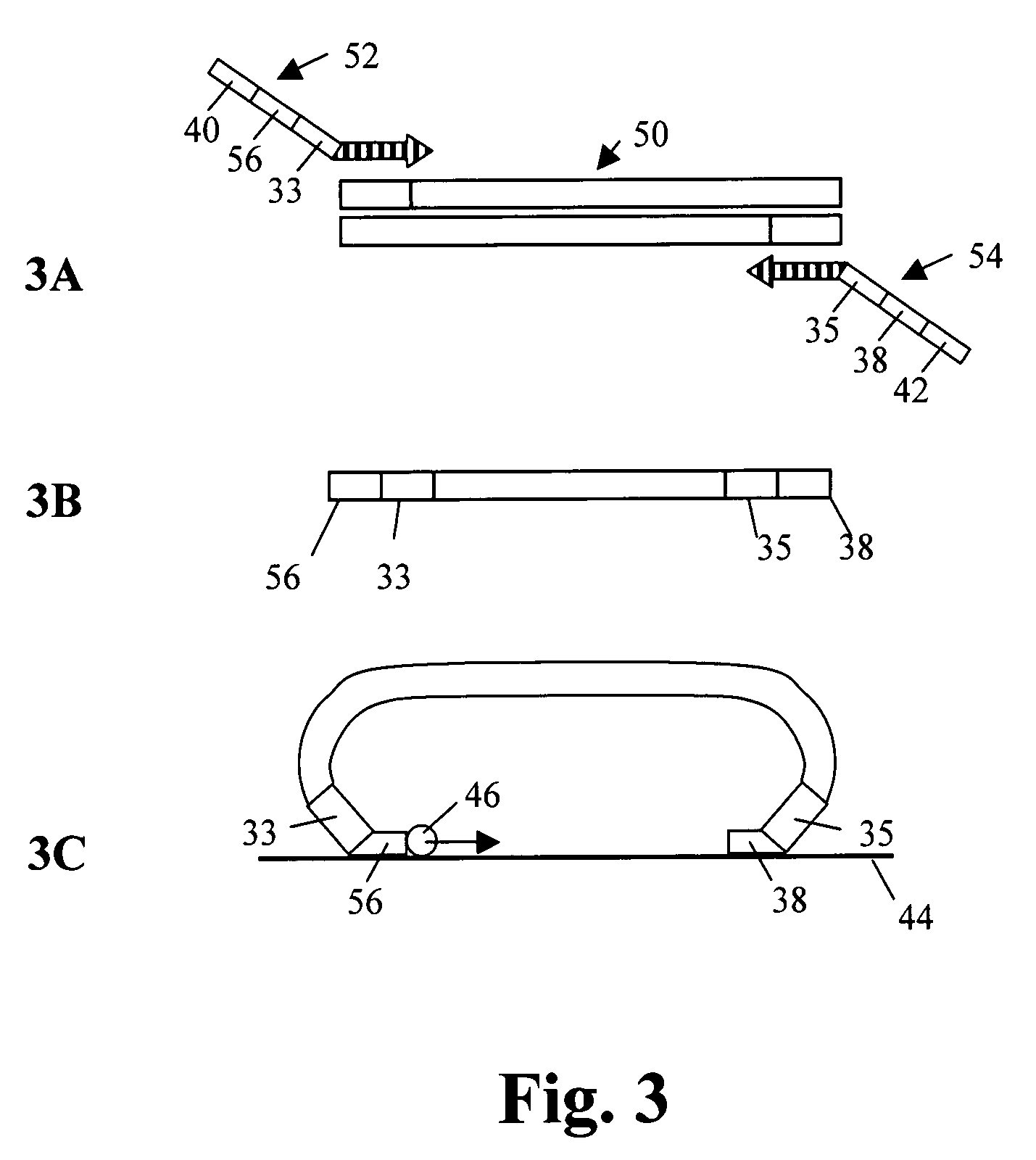Method to produce single stranded DNA of defined length and sequence and DNA probes produced thereby
a technology of dna probes and probes, applied in the field of nucleic acid synthesis and analysis, can solve the problems of reducing efficiency, high cost of manufacture of probes, and inability to meet large-scale genomic studies economically feasibl
- Summary
- Abstract
- Description
- Claims
- Application Information
AI Technical Summary
Benefits of technology
Problems solved by technology
Method used
Image
Examples
example 1
Probe Synthesis
[0071]The desired single-stranded probe we want to create is 298 bp. and the sequence of the molecule is
[0072]
SEQ ID NO: 485′TTGTTTTCTCCGTCGCCGTATCCCTTTAGTGAGGGTTAATAGTACGCTTACTTCCGCGAAACGTCAGCGGAAGCACCACTATCTGGCGATCAAAAGGATGGTCATCGGTCACGGTGACAGTACGGGTACCTGACGGCCAGTCCACACTGCTTTCACGCTGGCGCGGAAAAGCCGCGCTCG1CCGCCTTTACAATGTCCCCGACGATTTTTTCCGCCCTCAGCGTACCGTTTATCGTACAGTTTTCAGCTATCGTCACATTATTTAGGTGACACTATAGCCACAAATCAAGATCCGAATT3′
[0073]The underlined portions of the sequence represent the amplification primer sites described in Example 2, it being understood that the 5′ primer is the reverse complement of the underlined sequence. The probe sequence of SEQ ID NO: 48 above is derived from a double stranded DNA product, and it may be present in any organism or vector, as part of a larger sequence, and is set forth below in double stranded form as
[0074]
SEQ ID NO: 49AACAAAAGAGGCAGCGGCATAGGGAAATCACTCCCAATTATCATGCGAATGAAGGCGCTTTGCAGTCGCCTTCGTGGTGATAGACCGCTAGTTTTCCTACCAGTAGCCAGTGCCAC...
example 2
Multiplex Probe Design
[0089]Enzymatic synthesis of the long single-stranded molecule was derived from a double-stranded PCR product following the procedure described above.
1) Generation of Double Stranded Templates Shown in FIG. 3A
[0090]As shown in FIG. 3, double stranded DNA is first amplified using primers 52, 54. A 220 bp sequence from bacteriophage lambda, shown at 50, serves as starting point and a backbone for the probe. The phage was selected because its DNA would be non-hybridizable with human target DNA. The PCR amplification primers were synthesized with additional amplification primer 1 (AP1) sequence 33 on the forward primer and amplification primer 2 35 (AP2) sequence on the reverse amplification primers (FIG. 3A). These are common amplification primer targets for PCR using common primers for a multiple of probes in the downstream application. The molecule with the backbone and amplification primers was common for all the probes, except for the target sequences. The pro...
example 3
Probe Target Annealing
[0096]We compared the ability of the conventional sized MIPS that were chemically synthesized, and the SMART probes that we generated, in their ability to extend from the annealed target. The SMART probes had a spacer of 280 nucleotides in between the target sequences and the MIPS probe had a spacer of 80 nucleotides. This would typically be part of an overall SMART probe of a length of about 320 nucleotides. We discovered that the SMART probes we tested were able to amplify target molecules with gaps up to about 400 nt long. These gaps are filled in as part of the present process, and the content of the filled gap provides analytical information. The longest extension tested in Table 1 was 330, with the longest success at 175, but it is expected, based on DNA polymerization in other techniques, that the present methods and materials would work for longer extensions by varying the size of the spacer. The MIPS probes on the other hand were unable to extend molec...
PUM
| Property | Measurement | Unit |
|---|---|---|
| temperatures | aaaaa | aaaaa |
| volume | aaaaa | aaaaa |
| temperature | aaaaa | aaaaa |
Abstract
Description
Claims
Application Information
 Login to View More
Login to View More - R&D
- Intellectual Property
- Life Sciences
- Materials
- Tech Scout
- Unparalleled Data Quality
- Higher Quality Content
- 60% Fewer Hallucinations
Browse by: Latest US Patents, China's latest patents, Technical Efficacy Thesaurus, Application Domain, Technology Topic, Popular Technical Reports.
© 2025 PatSnap. All rights reserved.Legal|Privacy policy|Modern Slavery Act Transparency Statement|Sitemap|About US| Contact US: help@patsnap.com



